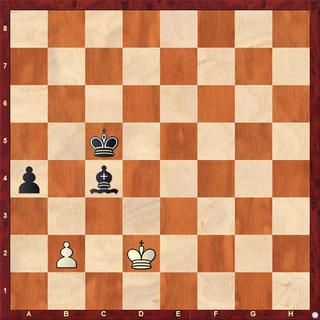White to Play
Published in Chess Puzzles

We’ve been talking about the wrong square color bishop allowing the weaker side to draw in rook pawn endings. This study by von Holzhausen, 1910, is a gem for teaching some of the intricacies because White can draw here or lose here, depending on how White plays it.
Only one move draws here, because all of these lose: 1.Kc1 Bd3 2.b4+ axb3 3.Kb2 Kc4 4.Ka1 Kb4 5.Kb2 Be2 6.Kb1 Kc3 7.Kc1 b2+ 8.Kb1 Bd3+ and 1.Kc3 Bb3 2.Kd2 Kc4 3.Kc1 Ba2 4.b4 a3 5.b5 Kxb5 6.Kc2 Kc4 7.Kc1 Kc3 an 1.Kd1 Bd3. Make sure you compare the main line that follows and why that works, but these alternatives don’t. You can see the lessons of the previous two problems emerging as well. 1.Kc2 1...Ba2 2.b4+ and not 2.Kc1 Kc4 3.Kc2 Kb4 4.Kd1 Bb1 5.Kc1 Bg6 6.Kd2 Kb3 7.Kd1 Kxb2 or 2.Kd3 Bb3 3.Kd2 Kb4 4.Kc1 Ba2 5.b3 Kxb3 2...axb3+ 2...Kxb4 3.Kb2 3.Kb2 Kb4 4.Ka1 Bb1 5.Kxb1 Kc3 6.Kc1 b2+ 7.Kb1 Kb3 Stalemate. Things to remember are how important it is to use the opposition if you’re on the stronger side and how to make sure your bishop doesn’t get trapped and, finally, how to keep that king out of getting to the corner. If you’re the weaker side, get to that corner of the opposite color square of the bishop and be ready to sacrifice your last pawn to achieve that goal.
Send questions and comments to PTamburro@aol.com.







Comments